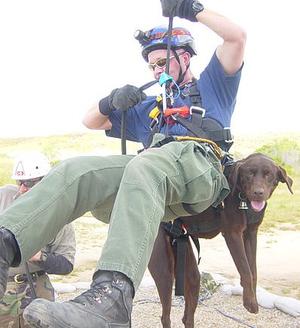Border securityBorder Patrol canines are outfitted with wearable electronics
Wearable electronics are expected to generate more than $14 billion in 2014, and the market will reach $70 billion by 2024.Wearable devices have been integrated into the daily tasks performed by Border Patrol agents. Thousands of border agents are currently outfitted with smart wrist-watches, wearable cameras, and clothing equipped with health and safety sensors capable of monitoring body temperatures and stress levels.Border Patrol canines are outfitted with GPS-connected collars which allow border agents to keep track of their whereabouts.

Border patrol dog and handler training in rappelling // Source: commons.wikimedia.org
Wearable electronics are expected to generate more than $14 billion in 2014, and the market will reach $70 billion by 2024, according to a study by researchers at IDTechEx. Sensor-equipped wearable devices used by law enforcement agencies, including the U.S Customs and Border Patrol (CBP), represent a growing segment of the market.
In a 6 October 2014 speech in Washington, D.C., CBP Chief Technology Officer Wolf Tombe discussed the integration of wearable devices into the daily tasks performed by Border Patrol agents. Thousands of border agents are currently outfitted with smart wrist-watches, wearable cameras, and clothing equipped with health and safety sensors capable of monitoring body temperatures and stress levels.
Tombe noted that the effectiveness of wearable devices in helping agents perform their jobs and improve safety may soon lead to wearable devices for the CBP’s canine teams. Border agents have long considered canines to be their best tool for tracking controlled substances at U.S. borders. CBP’s canine program is the largest among U.S. law enforcement agencies- roughly 1,500 teams are equipped with dogs trained to detect highly sensitive scents. “Canines are still our best sensors,” Tombe said.
NextGov reports that most Border Patrol canines are outfitted with GPS-connected collars which allow border agents to keep track of their whereabouts. In the future, those same collars may contain “stress-detection sensors” that could translate a dog’s bark to its mood, which could then be transmitted to an agent’s smart device. The technology could send vital information in real-time to agents such as whether the dog is stressed or threatened. Additionally, some versions of the collar could be designed to send data via an audio or video stream.
Israel-based Bio-Sense markets to the public a collar that interprets barks and can notify an owner if a dog “is alarmed, senses danger or is just communicating with neighbors.” The same collar transmits the information via SMS message or a cellular call.
